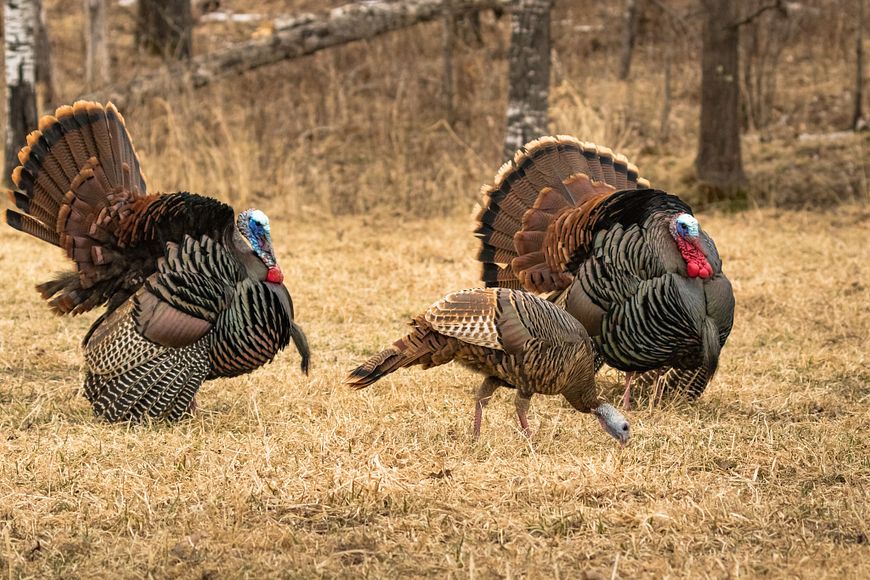Taste of Wisconsin
Turkey season stands steadfast in state’s most fickle months
Kyle Cherek
 © LINDA FRESHWATERS ARNDT
© LINDA FRESHWATERS ARNDTThere have been many things said over the eons about spring — ephemeral and more mercurial of a season than any other.
“It breaks your heart. It is designed to break your heart,” wrote the late A. Bartlett Giamatti, one-time commissioner of Major League Baseball. Giamatti was writing about the sport synonymous with spring, lamenting that opening day and spring itself would eventually yield to cold rains of autumn and the end of another baseball season.
Mark Twain, author and humorist noted, “In the spring, I have counted 136 different types of weather inside of 24 hours.” Any Wisconsinite can surely attest to that truth by Twain.
Spring, however — at least for the Wisconsin hunter — is more of an antidote to heartbreak than a precursor to it. The boots and overalls and sundry gear that sat idle over the winter, like a loyal hunting dog awaiting the right command, come to life again each April in Wisconsin for one big reason: spring turkey hunting.
Twain was imminently right about the weather, particularly in Wisconsin, on any given day in spring. My whole life has been peppered with days from March to May in which an optimistic warm wind is followed by a cumulonimbus cloud shift casting me in shade and chill.
In a way, that’s part of the fun and challenge of spring. Heartbreak or not, more verdant days are ahead and inevitable. You just have to hold tight.
TIME WITHOUT TURKEYS
Metaphorically, that’s the story of the wild turkey in Wisconsin, too.
By the mid 1800s, the native population of Wisconsin’s wild turkeys, then partial to the lower half of the state, was decimated. As homes and highways, farms and factories, cities and towns cleared the landscape of old-growth oak forests and warm cover, the crucial habitat of the wild turkey came to an end.
As the habitat goes, nature teaches us unequivocally, so goes the species.
Combined with unchecked hunting of the bird, there were literally multiple generations of Wisconsin hunters from the 1800s forward who never could hunt or even observe a wild turkey on our state’s natural landscapes.
For anyone who has lost themselves in the long, silent stalk of a wild turkey as it ambles over the stubby low-cut corn of a farmer’s field, or worked the call-and-response just right between hunter and tom as he draws close, they know generations without turkey hunting would be heartbreak, indeed.
WILD BIRD’S RECOVERY TALE
In the 1970s, the beloved birds were reintroduced via the DNR to our forests and fields. They came in small bits at first, with wild birds being wild-trapped in Missouri and initially released in Vernon County, heart of the Driftless Region.
The turkeys took to that habitat side by side with the same animals that had played such a seminal role in the state’s changed landscape and, in part, the turkey’s ouster — dairy cows.
From this modest success followed another broadening of the population, this time in the Kettle Moraine State Forest in the mid-1980s, and the numbers took off from there.
The Wisconsin wild turkey is now perhaps the most dynamic success story of state wildlife management to date. Curiously, the reintroduction of turkeys has given forth a bird that is just as happy to inhabit the previously off-limits northern part of the state.
This April and May, hunters in all 72 Wisconsin counties can bring their skills to bear with a turkey stamp.
AROUND THE WORLD AND BACK
To hunt wild turkey is a truly colonial American pursuit. The myth of the bird as a central meal item at the first Thanksgiving is rampant — and incorrect. Wisconsin deer hunters will be pleased to know that venison was really the main dish, along with an abundance of seafood.
The truth is, the turkey is an American species. Its early habitat spanned from eastern North America through Mesoamerica.
The turkey and the llama were the only domesticated animals the indigenous peoples of Mesoamerica had when the conquistadors showed up with guns, germs and horses in the early 1500s. Prized for its meat and maturation speed, within a decade of the Spanish conquest there were multiple turkey farms in their home country turning
a profit.
From there, the bird was bred and traded to ports such as Lisbon, Venice and Istanbul. By way of this trade, turkeys from Turkey — the empire credited with just about everything back then — reached England and were thus named.
But the settlers of Plymouth did not feast at first on turkey in the New World. The Wampanoag, the natives who lived in the region and joined the hostility truce meal we now call Thanksgiving, in essence said, “There are lots of them, we just don’t eat them.”
The irony we food historians appreciate is that the third wave of Puritan settlers who came to New England years after that first Plymouth colony included in its stores turkeys brought from England to breed and be eaten in the New World.
I love the idea of those English turkeys approaching the shore, gobbling as their distant and wild American turkey cousins watched from solid ground. The species had, at that point, come full circle.
RIGHT FOR SPRING
My first experience with a turkey hunt was all wait-and-see, with no bird at the end. Though there were three hens uphill from our blind with a tom downhill, the hens were either not in the mood or wary of our addition to the field.
The entertainment in the growing morning light was an erstwhile raccoon that ambled this way and that across the field as if he had misplaced his car keys the night before. My hunting buddies assured me the next time would be different, and for most Wisconsin hunters it is.
Turkeys now can be found in Wisconsin’s woods and field edges. By and large, they remain a healthy and stable species in our state.
Though turkey is a traditional autumn dish, here is a spring recipe using fresh thyme and lemon flavors that plays to those fleeting shoulder months between cold weather and hot.
 © COURTESY OF KYLE CHEREK
© COURTESY OF KYLE CHEREKKyle Cherek is a culinary historian, food essayist and former host of the Emmy Award-winning TV show “Wisconsin Foodie” on PBS. He and his wife own Amuse Bouche Entertainment Productions in Shorewood and together create unique culinary events including presentations, cooking demonstrations and storytelling dinners.
Roasted wild turkey
INGREDIENTS
1 stick (4 ounces) salted butter
2 lemons, 1 zested and juiced, the other cut into quarters lengthwise
1-2 teaspoons chopped fresh thyme leaves
1 teaspoon sliced lemon grass
1 fresh turkey, 10 to 12 pounds, prepared for cooking
Kosher salt
Ground black pepper
1 large bunch fresh thyme
1 red or Vidalia onion, quartered
1 head garlic, halved crosswise
INSTRUCTIONS
• Preheat the oven to 350. Melt the butter in a small saucepan. Add zest and juice of the lemon and 1 teaspoon of thyme leaves to the butter mixture. Stir and
set aside.
• Wash the turkey inside and out. Remove any excess fat or pinfeathers and dry the outside. Place the turkey in a roasting pan.
• Liberally sprinkle salt and pepper inside the turkey cavity and do the same with the sliced lemon grass, then roll from side to side to distribute the flavoring inside. Stuff the cavity with the bunch of thyme, lemon and onion quarters and garlic. (Note: How you cut or crush garlic changes the flavor; one option is to use bulbs broken apart with the skin peeled off.)
• Brush the outside of the turkey with the butter and thyme mixture and sprinkle with salt and pepper. Tie the legs together with string and tuck the wing tips under the body.
• Roast for about 2½ hours, or until the juices run clear when you cut between the leg and the thigh. Remove the turkey to a cutting board, cover with aluminum foil and let rest for 20 minutes. Always use a meat thermometer to be sure the thickest part of the breast is at 165 degrees before resting. The temperature will rise after it rests as the proteins contract as they cool.
• After the meat rests, carve and enjoy.

